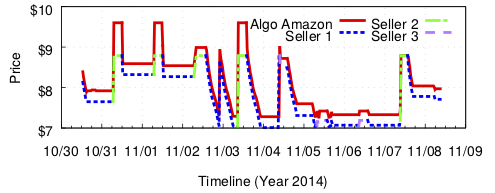
LEARNING OUTCOMES
At the end of the course the student has learned to understand and analyze firm decisions and strategies in online and digital markets through the lens of economics.
Credits: 6
Schedule: 03.09.2024 - 17.10.2024
Teacher in charge (valid for whole curriculum period):
Teacher in charge (applies in this implementation): Iivo Vehviläinen
Contact information for the course (applies in this implementation):
Please contact me at iivo.vehvilainen@aalto.fi.
CEFR level (valid for whole curriculum period):
Language of instruction and studies (applies in this implementation):
Teaching language: English. Languages of study attainment: English
CONTENT, ASSESSMENT AND WORKLOAD
Content
valid for whole curriculum period:
Economic approch for analyzing strategic interactions between firms, introduction to auction theory with emphasis on online advertisement auctions, and preliminaries of network effects and platform economics. Practical applications are used to illustrate how digital and online markets differ from traditional markets, what economic theories are behind successful online platforms, and where and how markets should be regulated.
applies in this implementation
Most valuable firms in the world are platforms that operate online and offer digital market channels. This course introduces the students to the economic analysis of platform design, pricing, and policy.
The course is roughly divided into two parts. As an introduction to the first part, we review the economic approach to analyzing firm strategies, and go through the basic workhorse models of competition. We use these tools to understand what has made online and digital marketplaces so successful. The key concepts are preferences and data on it (what people want to do) and efficiency of using the data (how to achieve what people want to do). Particular attention is on auctions, a popular method for selling advertisements and goods in online markets.
The second part of the course covers the economics of platforms that serve two sides of a market (for example consumers and advertisers). A requisite to understanding how such a platform can be successful is the analysis of the network effects that additional participants bring to the platform. We study the two most important strategies that a platform firm chooses: pricing and openness, and introduce the models of platform competition. We conclude by an overview of the policy and regulatory issues, such as the role of privacy, the market power of platform giants, and discrimination and other externalities.
Assessment Methods and Criteria
valid for whole curriculum period:
Exam and assignments
Workload
valid for whole curriculum period:
Contact teaching, independent work, exam
applies in this implementation
Contact teaching 30h
Independent work 127h
Exam 3h presence
Total 160h (6 ECTS)
DETAILS
Study Material
valid for whole curriculum period:
Reading material assigned during the course.
applies in this implementation
Textbook
We have no textbook for now. If you want to learn more economics in any case, then any microeconomics textbook should be helpful throughout the course. For example, Hal Varian, “Intermediate Microeconomics: A Modern Approach” (Eighth Edition or higher), is not a bad choice. Purchase of such book for this course is not mandatory; the material listed here and given at the lectures is more than sufficient as well.
Online textbook (CORE)
The numbering in the schedule refers to free ebook “The Economy” by the CORE initiative, which makes a good read otherwise as well, see https://www.core-econ.org. We will be building on principle level economics throughout the course. If in need, you'll probably be well served by familiarising with the following topics:
• Preferences (CORE 3.2-3.5), basics of game theory (4.1-4.3)
• Pareto efficiency (CORE 5.2)
• Institutions, supply and demand (CORE 8.1, 8.2), competitive equilibrium (CORE 8.5)
• Perfect competition (CORE 8.8), monopoly, oligopoly
Online videos (MRU)
Or if you prefer learning through videos, see the Principles of Economics: Microeconomics course by the Marginal Revolution University https://mru.org/courses/principles-economics-microeconomics/introduction-microeconomics. In particular, at least the
following parts will be useful:• Supply, Demand, and Equilibrium
• Elasticity and Its Applications
Additional material and reading instructions will be given during class.
Substitutes for Courses
valid for whole curriculum period:
Prerequisites
valid for whole curriculum period:
SDG: Sustainable Development Goals
8 Decent Work and Economic Growth
9 Industry, Innovation and Infrastructure
FURTHER INFORMATION
Further Information
valid for whole curriculum period:
Teaching Language: English
Teaching Period: 2024-2025 Autumn I
2025-2026 Autumn I
Details on the schedule
applies in this implementation
Tentative schedule
Lecture 1 INTRODUCTION
• Practicalities of the course
• Efficiency
Lecture 2 PREFERENCES
• Preferences (CORE 3.2-3.5, 3.7.1)
• Institutions, supply and demand (CORE 8.1, 8.2)
Lecture 3 COMPETITION
• Competitive equilibrium (CORE 8.5)
• Monopoly, oligopolistic competition
Lecture 4 AUCTIONS
• Motivation: price discovery, competition
• Auction types
Lecture 5 MARKET DESIGN
• Setting the right incentives
• Finding preferences
• Implementation of ad auctions
Lecture 6 ONLINE MARKETS
• Role of frictions, data, trust
• Macro-level effects
Lecture 7 NETWORKS
• Complementarity (CORE 21.3)
• Network effects (CORE 21.4)
Lecture 8 PLATFORMS
• Two sided markets (CORE 21.5)
• How platform grow (and shrink)
Lecture 9 PLATFORM PRICING
• Impact of externalities
• Monopoly pricing
Lecture 10 SHARING ECONOMY
• Platform competition
• Peer-to-peer markets
• Trust, reputation
Lecture 11 DIGITAL GOODS
• Non-rival goods, monetizing
• New technologies
Lecture 12 REGULATION AND POLICY
• Digital rights
• Discrimination
• Market power
• Externalities
